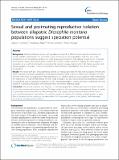Files in this item
Sexual and postmating reproductive isolation between allopatric Drosophila montana populations suggest speciation potential
Item metadata
| dc.contributor.author | Jennings, Jackson H. | |
| dc.contributor.author | Mazzi, Dominique | |
| dc.contributor.author | Ritchie, Michael G. | |
| dc.contributor.author | Hoikkala, Anneli | |
| dc.date.accessioned | 2012-11-16T15:01:01Z | |
| dc.date.available | 2012-11-16T15:01:01Z | |
| dc.date.issued | 2011-03-14 | |
| dc.identifier | 13112321 | |
| dc.identifier | 05706039-c5af-47c8-825d-be4db1da4ed7 | |
| dc.identifier | 000289414700001 | |
| dc.identifier | 79952495994 | |
| dc.identifier.citation | Jennings , J H , Mazzi , D , Ritchie , M G & Hoikkala , A 2011 , ' Sexual and postmating reproductive isolation between allopatric Drosophila montana populations suggest speciation potential ' , BMC Evolutionary Biology , vol. 11 , 68 , pp. - . https://doi.org/10.1186/1471-2148-11-68 | en |
| dc.identifier.issn | 1471-2148 | |
| dc.identifier.other | ORCID: /0000-0001-7913-8675/work/46761161 | |
| dc.identifier.uri | https://hdl.handle.net/10023/3249 | |
| dc.description | This work was funded by a European Commission Research Training Grant RTN2-2001-00049, the Centre of Excellence for Evolutionary Research at the University of Jyväskylä and a Marie Curie Initial Training Network, ‘Understanding the evolutionary origin of biological diversity’ (ITN-2008-213780 SPECIATION) | en |
| dc.description.abstract | Background: Widely distributed species with populations adapted to different environmental conditions can provide valuable opportunities for tracing the onset of reproductive incompatibilities and their role in the speciation process. Drosophila montana, a D. virilis group species found in high latitude boreal forests in Nearctic and Palearctic regions around the globe, could be an excellent model system for studying the early stages of speciation, as a wealth of information concerning this species' ecology, mating system, life history, genetics and phylogeography is available. However, reproductive barriers between populations have hereto not been investigated. Results: We report both pre- and postmating barriers to reproduction between flies from European (Finnish) and North American (Canadian) populations of Drosophila montana. Using a series of mate-choice designs, we show that flies from these two populations mate assortatively (i.e., exhibit significant sexual isolation) while emphasizing the importance of experimental design in these kinds of studies. We also assessed potential postmating isolation by quantifying egg and progeny production in intra-and interpopulation crosses and show a significant one-way reduction in progeny production, affecting both male and female offspring equally. Conclusion: We provide evidence that allopatric D. montana populations exhibit reproductive isolation and we discuss the potential mechanisms involved. Our data emphasize the importance of experimental design in studies on premating isolation between recently diverged taxa and suggest that postmating barriers may be due to postcopulatory-prezygotic mechanisms. D. montana populations seem to be evolving multiple barriers to gene flow in allopatry and our study lays the groundwork for future investigations of the genetic and phenotypic mechanisms underlying these barriers. | |
| dc.format.extent | 10 | |
| dc.format.extent | 439632 | |
| dc.language.iso | eng | |
| dc.relation.ispartof | BMC Evolutionary Biology | en |
| dc.subject | Incipient speciation | en |
| dc.subject | Premating isolation | en |
| dc.subject | Courtship song | en |
| dc.subject | Selection | en |
| dc.subject | Melanogaster | en |
| dc.subject | Evolution | en |
| dc.subject | Divergence | en |
| dc.subject | Patterns | en |
| dc.subject | Reinforcement | en |
| dc.subject | Perspective | en |
| dc.subject | QH301 Biology | en |
| dc.subject.lcc | QH301 | en |
| dc.title | Sexual and postmating reproductive isolation between allopatric Drosophila montana populations suggest speciation potential | en |
| dc.type | Journal article | en |
| dc.contributor.sponsor | European Commission | en |
| dc.contributor.sponsor | NERC | en |
| dc.contributor.institution | University of St Andrews. Institute of Behavioural and Neural Sciences | en |
| dc.contributor.institution | University of St Andrews. School of Biology | en |
| dc.identifier.doi | 10.1186/1471-2148-11-68 | |
| dc.description.status | Peer reviewed | en |
| dc.identifier.grantnumber | 213780 | en |
| dc.identifier.grantnumber | NE/E015255/1 | en |
This item appears in the following Collection(s)
Items in the St Andrews Research Repository are protected by copyright, with all rights reserved, unless otherwise indicated.

